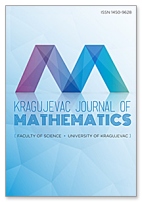Note on Hamiltonian Graphs in Abelian 2-Groups
 Download PDF
Download PDF
Authors: K. TABAK
DOI: 10.46793/KgJMat2503.401T
Abstract:
We analyze a graph G whose vertices are subgroups of ℤ2k isomorphic to ℤ2 × ℤ2. Two vertices are joined if their respective subgroups have nontrivial intersection. We prove that such a graph is 6(2k−2 − 1)-regular. If a graph is regular, a classical theorem by Ore claims that a graph is Hamiltonian if the degree of any vertex is at least one half of the number of vertices. Using Ore’s theorem, we show that G is Hamiltonian for k ∈{3, 4}. Ore’s theorem cannot be applied when k ≥ 5. Nevertheless, we manage to construct a Hamiltonian cycle for k = 5. Our construction uses orbits of one ℤ24 group under an action of an automorphism of order 31. It is highly likely that this approach could be generalized for k > 5.
Keywords:
Hamiltonian graph, graph, elementary Abelian group, subgroup, group ring.
References:
[1] A. Abdollahi, S. Akbari and H. R. Maimani, Non-commuting graph of a group, J. Algebra 298(2) (2006), 468–492. https://doi:10.1016/j.jalgebra.2006.02.015
[2] D. F. Anderson and P. S. Livingston, The zero divisor graph of a commutative ring, J. Algebra 217(2) (1999), 434–447. https://doi.org/10.1006/jabr.1998.7840
[3] P. Balakrishnan, M. Sattanathan and R. Kala, The center graph of a group, South Asian J. Mathematics 1 (2011), 21–28.
[4] A. Abdollahi and A. M. Hassanabadi, Noncyclic graph of a group, Comm. Algebra 35(7) (2007), 2057–2081. https://doi.org/10.1080/00927870701302081
[5] B. Bollobás, Modern Graph Theory, Springer-Verlag, New York, 1998.
